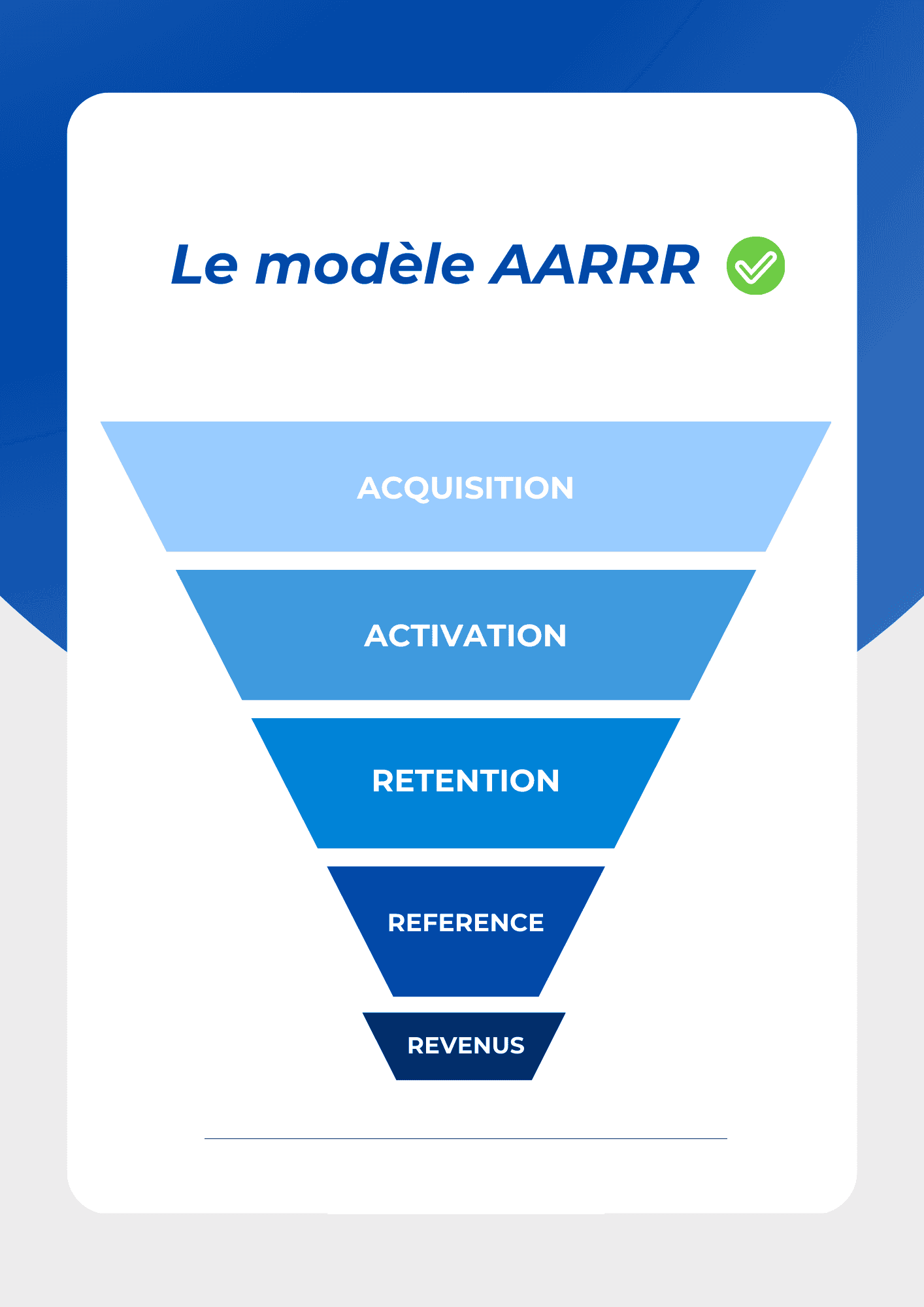Introduction
Growth hacking is a term that often resonates in the startup ecosystem, denoting a revolutionary approach that propels growth quickly and cost-effectively. Are you curious to understand the essence of growth hacking? Are you thinking about how to implement it in your own company?
In this article, we’ll clearly define growth hacking, identify its fundamental principles and explore the most effective methods for boosting your growth in 2024. We’ll also illustrate our point with inspiring case studies of small businesses that have made the most of growth hacking. You’ll see how this method can become an influential growth tool for your business.
Understanding growth hacking: definition and key principles
Growth hacking is a concept that refers to marketing methods hyper-focused on accelerating the growth of a product or company. Born in the ecosystem of startups, often faced with the imperative of growing fast with limited resources, growth hacking aims to maximize user or customer acquisition while minimizing costs.
A growth hacker relies on a range of analytical, creative and innovative methods to achieve his goals. These techniques include, among others, A/B testing, landing page optimization, exploiting viral factors, improving email deliverability, and integration with Open Graph. This growth professional relies on rigorous data analysis and a series of experiments to fine-tune the customer experience and multiply successful initiatives.
Growth hacking is based on several fundamental principles:
- The product, at the heart of any growth strategy, must address an explicit need and offer significant added value to users. MirrorProfiles, for example, has a clear and simple offer. In 2024, your offer must be understood in less than 5 seconds.
- Growth hacking targets not a general audience, but a specific, carefully determined market segment with a high propensity to adopt the product.
- The growth hacking approach is iterative: defining objectives, formulating hypotheses, experimenting with solutions, observing the results, then optimizing and repeating the process.
- The method is based on the AARRR model (Acquisition, Activation, Retention, Revenue, Referral), which delineates the different phases of the user journey and identifies the key performance indicators. To understand this method, think of a funnel: if one part is pierced, the expected result will be less.
In the rest of this article, we’ll explore the most effective growth hacking strategies for initiating and propelling rapid growth. We’ll also present case studies of small businesses that have successfully applied growth hacking techniques.
Growth Hacking Strategies for Start-Up and Accelerated Growth
Having grasped the basics of growth hacking, it’s time to think about how it can be applied to a small business.
A quick note before we start: growth hacking isn’t magic, it’s about accelerating growth, not creating it. Clearly, if your business isn’t growing and doing well, growth hacking won’t be the magic bullet. This method aims to go faster, further and increase ROI. It’s like a multiplier index in an equation, except that 0 times any factor will always equal 0.
Now that that’s said, let’s discover the most effective growth hacking techniques for attracting, retaining and monetizing your customer base.
The importance of Experimentation and Measurement
Growth hacking is based on a repeated cycle of testing, measuring and continuous learning. Rather than limiting himself to the tried and tested methods of conventional marketing, the growth specialist is constantly looking for innovative ways to stimulate growth, tailored to his offer and his market. New ideas are based on experimentation, hypotheses and data analysis.
Experimentation is crucial to verify assumptions and identify the most promising tactics. We need to create rapid, cost-effective tests to assess the effect of our initiatives on key performance indicators (KPIs). Tools such as Google Analytics, Optimizely or Hotjar are frequently used to examine user behavior, conversion rates, retention rates and customer acquisition costs. Here, the focus is on the website. But growth hacking methods are mainly applied to outbound prospecting.
It’s essential to measure in order to quantify successes and learn from them. The growth hacker collects, processes and interprets data to extract relevant information and act accordingly, optimizing strategies according to the data gathered. This dynamic of experimentation and measurement will continue until we reach our growth targets.
Common Growth Hacking Techniques for Small Businesses
There’s no one-size-fits-all formula when it comes to growth hacking, as each offer and market is unique, with its own specificities. However, some growth hacking approaches stand out for their effectiveness and can be adapted to a wide range of contexts. Let’s list a few proven growth hacking strategies for small businesses:
- Affiliate marketing: encourage your customers to recommend your offers by offering them benefits for each referral. Dropbox, for example, rewards additional storage space for successful referrals.
- Content Marketing: produce and share quality topics that bring value while generating traffic and conversions. Buffer, for example, regularly publishes captivating topics on marketing and social networks.
- Email marketing: use email as a direct, personalized means of communicating with your audience. Airbnb, for example, sends personalized offers to its consumers based on their recent searches on the platform.
- SEO (Search Engine Optimization): optimize your online platform for higher search engine rankings, attracting more qualified visitors. Wix, for example, offers a free tool to help users improve their SEO presence.
- Social Network Marketing: leverage social networks to promote your offer by creating engaging, viral content. Netflix uses this strategy to generate excitement around its films and series with creative publications.
- Linkedin: direct prospecting on Linkedin is a goldmine in many ways. This network enables you to build up prospecting files quickly and contact your key contacts directly.
Product innovation, the cornerstone of growth
Growth hacking isn’t just about marketing; it also embraces the supply side of the equation, which is essential for building loyalty and generating value. The growth hacker must innovate and perfect his offer on an ongoing basis, relying on customer feedback and expectations. Outbound marketing is essential here, because the prospects you contact will give you informed feedback, sometimes without even realizing it. If, for example, your response rate on Linkedin is below 20% of your target audience, then either the subject of the messages is not the right one, or your offer does not directly meet their needs.
This innovation can take various forms, depending on the stage of development of your offer and the maturity of the market. Here are a few examples of innovations that can catalyze growth:
- The MVP (Minimum Viable Product): launch your offering with the essential functions to meet users’ primary needs. Zappos, for example, initially sold shoes online without stock, using photos from traditional stores.
- The Pivot: consider a radical change, if the original idea doesn’t bear fruit. Slack has evolved from an online game into a communication platform for teams.
- Feature hacking: integrating or modifying a key functionality to amplify growth or virality. Instagram introduced Stories inspired by Snapchat.
- UI/UX Design: improve the interface and user experience to make the offer more intuitive and effective. Spotify offers an excellent example with its personalized playlists and music recommendations.
The article concludes with case studies of small businesses that have successfully used growth hacking to stand out from the competition.
Case studies : Small businesses and growth hacking
Intrigued by growth hacking? You’ve already had a taste of its essential principles and impactful methods for boosting growth. Now let’s delve into its practical application for small companies. Let’s discover some inspiring success stories together.
Small business success stories using growth hacking
Contrary to popular belief, growth hacking isn’t just for big companies or tech start-ups. It’s also within the reach of small, ambitious companies, provided they have a relevant offering and are prepared to experiment and innovate. Let’s take a look at several cases of small businesses that have propelled their growth through growth hacking:
- Act! : This CRM (Customer Relationship Management) solution supports small companies in optimizing their marketing, sales and customer service. Act! has boosted its subscriber base with a 14-day free trial, improved its SEO, offered quality content on its blog, relied on retargeting to win back site visitors, and launched a referral program to reward referrals.
- Wix: A website creation platform, Wix has made a name for itself by offering a free service branded with its logo, encouraging consumers to share their creations on social media, developing creative advertising campaigns and optimizing its SEO to target strategic keywords.
- Buffer: A tool for managing and scheduling content on social networks, Buffer has won over a loyal following thanks to a free basic version, relevant content on its blog, email marketing campaigns with tailored advice, and integration with other popular applications.
- MirrorProfiles: Rental service for heated, secure Linkedin accounts, ready for automation. MirrorProfiles first iterated its value proposition by deploying only outbound prospecting campaigns for 1 year. Once the sales pitch was clear, we deployed the SEO channel to meet a strong need for market evangelism on this topic. The automatic translation of our articles into English has enabled us to conquer an American, English and German market.
There are thousands of inspiring success stories that will suit your product or service. Growth hacking literally works for any growing company that wants to accelerate its deployment. In fact, don’t hesitate to take a demo with our team to submit your ideas. As experts, we can advise you on the best method to adopt.
Adapting growth hacking to different business sectors
Growth hacking embraces all sectors, and can be finely adapted if you know your market, your customers and your competitors well. Growth hackers uncover the ideal opportunities and growth levers for their offer and sector. Here are a few examples specific to several domains:
- E-commerce: In e-commerce, growth hacking can boost traffic, conversion rates and average basket value. Tactics such as “social proof” can convince visitors to buy. Others, such as creating a sense of urgency or scarcity with limited stocks or one-off offers, encourage immediate purchase.
- Tourism: For tourism companies, capturing attention, making an impression and building loyalty often involve storytelling (telling an attractive story about a product or place) and gamification (adding playful elements to engage customers).
- Education: The education sector can make use of growth hacking by proposing freemium offers – free for the base and paying for additional features – and collecting user feedback to improve and personalize offers.
To conclude this article, let’s review the key elements of growth hacking and share a few tips to get you started with confidence.
Conclusion
Growth hacking is a revolutionary approach (even in 2024) that propels the rapid and sustained growth of small businesses. This method aligns marketing and product development strategies with value creation, while relying on fundamental principles such as product-market fit, experimentation, precise measurement of results and constant innovation. Growth hacking can be adapted to different sectors, and the many success stories are substantial sources of inspiration.
Here are some key steps to get started with growth hacking:
- Clarify what problem your product or service solves, what need it satisfies, and what unique value it offers.
- Clearly define your market segment, identify your ideal customer and formulate your distinctive value proposition.
- Select key performance indicators (KPIs) aligned with your growth objectives, and implement appropriate monitoring and analysis systems.
- Formulate hypotheses, carry out tests, observe feedback, and adjust your methods according to the data collected.
- Stay in innovation mode by constantly fine-tuning your product or service according to your customers’ feedback, expectations and needs.
Don’t put your project on hold – get involved in growth hacking today! You’ll find that this methodology can become a powerful engine for the expansion of your small business.
FAQ
What are the 3 pillars of Growth Hacking?
The three fundamental pillars of Growth Hacking are: acquiring new consumers, retaining existing users and improving engagement by increasing frequency of use. They are supported by a rigorous methodology that integrates precise segmentation and continuous testing, in-depth tracking analysis, constant optimization and the quest for maximum coverage (saturation).
How does Growth Hacking work?
Growth Hacking is a strategic marketing approach focused on accelerating business growth through innovative and cost-effective methods. This strategy draws on data-driven analysis, agile experimentation and digital word-of-mouth to attract new consumers and convert them into loyal customers.
Why become a Growth Hacker?
This enables us to catalyze the growth of a company, especially a startup, by leveraging creative strategies, cutting-edge methods and in-depth data observation, all with limited resources. This dynamic role combines technical skills and inventiveness, requiring both specific training and substantial practical experience.
Who invented Growth Hacking?
The concept of Growth Hacking, an efficiency-driven marketing approach to stimulate the rapid growth of companies, especially startups, was conceived by Sean Ellis. A distinguished American entrepreneur and investor, he is best known for founding GrowthHackers.com in 2010, and formalizing the practice.






